Although the American dream used to involve a white picket fence and a nice-sized home, some are opting for a pocket-sized alternative. As many people look to simplify their lives and rethink their priorities, living in a dramatically smaller home is appealing to an increasing segment of the population. After all, how much space do we truly need to be happy?
What is a tiny home?
They range anywhere from 70 to 400 square feet, according to the American Tiny Home Association, and most are designed for year-round living.
These miniature houses provide all the necessary elements of a home in a very small footprint, thus making extremely efficient use of space. Many are insulated, and they often contain customized features, such as granite counters and spacious yards. Tiny homes include all the typical spaces as a traditional home: kitchen, sleeping area, living room, an eating area, and storage — just trimmed way down to a really compact size.

Some are located in cities and urban landscapes while others are in remote areas. There are even tiny home communities that create neighborhoods with these small-scale houses.
What options exist for tiny homes?
Tiny homes come in all shapes and sizes, from repurposed shipping containers to yurts, while others have timber frames. Some even come on wheels to make them more mobile or to avoid building codes or property taxes. Often, appliances from the boating or RV industry can be used, such as mini water heaters, appliances, space heaters, and plumbing fixtures. Their compact design can be perfect for a tiny abode.
In some cases, owners build their tiny homes for just several thousand dollars using salvaged materials. Some are built using prefab house kits and include high-end custom features that boost the total cost considerably. Solar panels, composting toilets, rain barrels, or a solar orientation for passive heating and cooling are optional green features that can reduce resource consumption.
Are tiny homes subject to building codes?
To ensure that your tiny home is legal, refer to local building codes, zoning guidelines, and neighborhood association rules where applicable. In general, if a house has a foundation, it needs to abide by local building codes and zoning restrictions and is subject to property taxes. When on wheels, RV guidelines may apply to tiny homes. Building codes vary but some take tiny homes into account while many do not.
To help make tiny homes a more mainstream housing option, advocates have been encouraging code changes in some areas. In Oregon, building codes were altered to allow structures under 600 feet to have sleeping lofts with ladder access. These miniature houses don’t just conserve resources, they can boost affordable housing options in an area, catching the eye of some local governments. In San Diego, the city council is exploring tiny home options to mitigate the housing crisis.
Is bigger better?
The average new home has increased in size from 1,660 square feet in 1975 to 2,620 in 2018. The average American spends more than a third of their income on housing. Tiny homes contradict the notion that bigger is better and that homeownership requires a large mortgage.
Bigger homes tend to be more expensive to own because they have higher energy bills, are more expensive to maintain, have higher property taxes, and are more work to clean and furnish. By contrast, the tiny home movement helps make homeownership available to a larger segment of the population. They are ideal for urban infill initiatives because some cities have miniature lots available that are too small for a typical home.
Is a tiny home for me?
Living small isn’t for everyone and entails a lifestyle change for many.
Because of their limited storage space, tiny homes encourage owners to limit material possessions. Keep in mind, tiny homes do not require living small, and the vast majority have easy access to the outdoors. Many tiny homes have spacious yards with outside spaces to entertain and recreate.
If a tiny home seems too drastic, perhaps a small house would suit you better. They typically range from 400 to 1,000 square feet, thus having many of the same benefits but on a smaller scale.
The post Will Your Next House Be a Tiny Home? appeared first on Earth 911.








